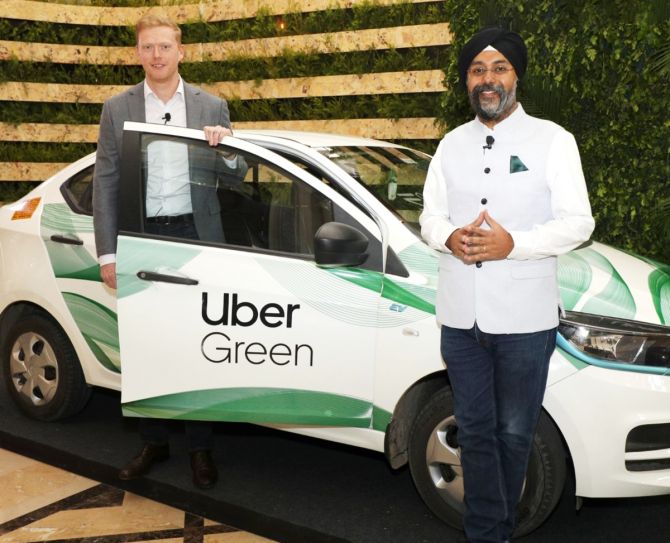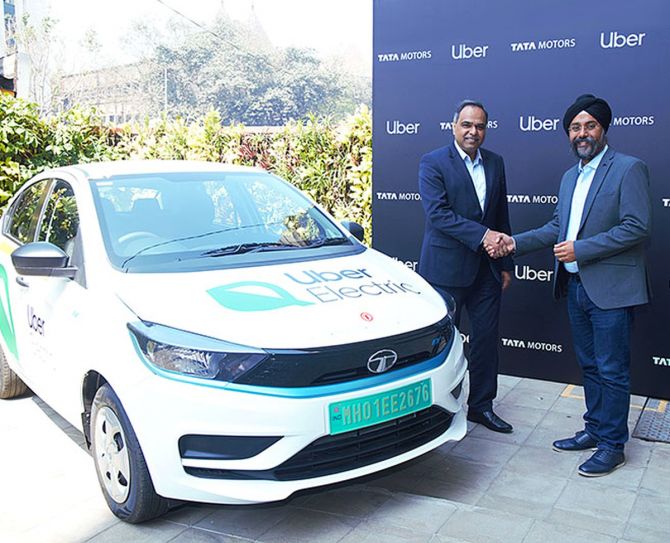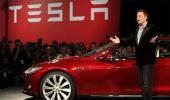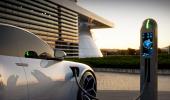By 2025, Uber projects that 25,000-30,000 cars -- or 12 to 16 per cent of vehicle additions -- would be EVs, reports Surajeet Das Gupta.

Uber Inc is making a quiet tryst with electric vehicles (EVs).
In the next three years, based on its demand projection, the shared mobility aggregator said it would need 150,000 to 200,000 new vehicles to be boarded on its platform to cater partly to expansion and partly to replacing old vehicles.
But this time, Uber has included a new parameter in its plan.
By 2025, 25,000-30,000 cars -- 12 to 16 per cent of vehicle additions -- would be EVs.
It will replicate this model in two-wheelers, for which it has tied up with Zypp, a D2C start-up, as an electric fleet partner and in three-wheelers, though availability is still limited with Bajaj Auto being the only major player. The numbers for the latter two would be larger.
But the immediate big bet is in electric cars. Penetration of electric cars is in its infancy (just over 1 per cent) and only around 40,000 electric cars were sold last year.
Even with the second edition of the subsidies under the Faster Adoption and Manufacturing of (Hybrid &) Electric Vehicles (FAME 2) schemes, the vehicles are expensive -- there is no sub-Rs 10 lakh product available to push volumes yet.
If FAME 2 is withdrawn from next year, EV car prices will go up by Rs 1 lakh-2 lakh.
The second problem is the lack of charging stations. So, the exercise is far more complex than what Uber is used to doing when it onboards driver partners with CNG vehicles -- a well-established system backed by easily available bank finance.
To crack the EV play, Prabhjeet Singh, president, India and South Asia, of Uber that has operations in over 125 cities, said: “The whole approach is of deep partnership. As the ecosystem is nascent, multiple players have to come together to do what they are best at rather than one player doing a full-stack solution. Apart from providing the marketplace, Uber will stitch together these various parts of the ecosystem and provide driver-partners the comfort that they would make money.”
In February this year, Uber signed an agreement with Tata Motors to supply 25,000 electric cars in three years.
Earlier, Uber faced the problem of a lack of vehicles in the right range for commercial use (the best was 120 km per charge). But the introduction of Tata Motors' Ziptron resolved the issue -- it offers a range of over 210 km (though actual range might be much lower). It is a non-exclusive arrangement; Uber is testing other vehicles, too.
As part of its asset-light strategy, Uber is collaborating to share the risks as well as the upside and has tied up with three major fleet owners -- Bengaluru-based Lithium, a B2B all-electric fleet company, Everest, which already runs a CNG fleet on Uber, and Moove, its global partners -- to buy these cars and then run it on their platform with their drivers.

What Uber brings to the table is its heft to ensure that fleet owners get volume discounts while buying their cars.
It also helps in negotiating better financial terms for loans -- for instance, it has tied up with SIDBI, which has agreed to extend a loan book of Rs 1,000 crore to their preferred partners at a lower rate of interest.
Singh said Uber is also tying up with charging stations, providing them commitment of utilisation of their stations from Uber's fleet owners, provided the aggregator gets preferential rates.
It is only with this commitment that Uber will invest in more charging stations, he added.
It also offers its fleet partners minimum guarantees of business.
It shortly plans to roll out a separate branded electric service, Uber Green, initially in Delhi, Mumbai and Bengaluru.
So, will consumers have to pay a premium for the service? Singh said that all Uber's research has shown that India is a price-sensitive market so that is unlikely. But it will give consumers, who want to book only a new EV car but are also willing to wait a bit longer (because the availability will be much smaller than a CNG car), an alternative.
Uber, however, contradicts the myth that low operating costs in EVs should translate into lower tariffs.
Singh pointed out that the upfront cost of the car is far higher (Rs 12.5 lakh for the Tata car) and could go up if FAME 2 is withdrawn completely.
So, the benefit of lower operating costs versus a conventional vehicle would kick in much later, maybe in the fourth or fifth year.
Fleet owners are not complaining. For instance, Lithium, which has a fleet of 3,000 electric cars and operates in the B2B segment, is looking at putting in 10,000 vehicles on the platform in 12 to 34 months.
In this financial year, its target is to go for 1,000 electric cars on Uber.
Sanjay Krishnan, founder of Lithium Urban Technologies, said: “We remain a B2B player but now we have Uber as a customer. Joining their platform where demand is high will help us in better cross-utilisation of our fleet.”
He added that it is difficult to project whether its margins on the Uber business will be better than its existing B2B business.
Singh concedes that Uber's EV foray is a long-term plan as this transition is a paradigm shift.
For the last few years, CNG-powered vehicles have dominated the marketplace, and the shift for drivers who own ICE and CNG vehicles to EVs will need an enabling environment.
It already faces competition from companies, which have taken an alternative strategy to push EV for mobility.
BluSmart is slowly expanding in more cities -- but unlike, Uber it owns and runs its own fleet of electric cars as well the platform for customers to book service and has no legacy issues of ICE cars to tackle.
Analysts say controlling the entire chain helps them ensure quality of service like better cars and on-time records -- issues with which both Uber and Ola are struggling.
Indeed, Uber also has to contend with the fact that its traditional rival Ola is planning to leverage its sister company Ola Electric to customise vehicles for captive consumption for two-, three- and eventually four-wheelers.
The following year will determine which competitor is the winner in the EV sweepstakes.
Sparks of change
- Uber plans to put in 25,000-30,000 electric cars on its platform in three years. It is following an asset-light strategy by tying up with fleet owners who will own the cars; has tied up with Zypp that has electric two-wheelers to be on its platform
- Ola is looking at leveraging Ola Electric by manufacturing and selling their two-, three- and four-wheelers to their riders backed by attractive financing. It will help both its ride and manufacturing business
- Lithium: It plans to expand its B2B business and utilise existing fleet more efficiently
- BluSmart, with 3,500 electric cars, is planning to ramp it up to 10,000 by FY24, making it one of the biggest players in the business as it expands to more cities. It has recently raised funds; it will own and operate and offer services to customers
Feature Presentation: Rajesh Alva/Rediff.com











